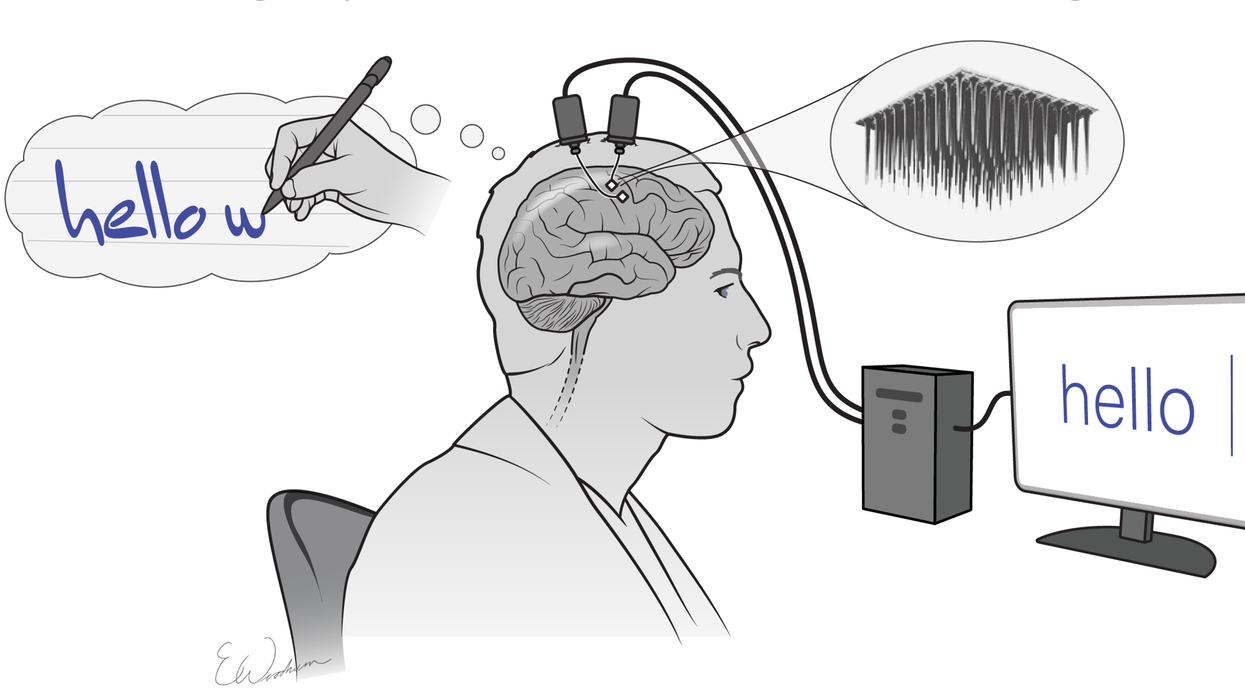
A paralysed man has used his brain to write on a screen at speeds almost as fast as an able-bodied adult, according to a new study.
Researchers have developed a method of communication for people with paralysis that uses a computer to turn mental handwriting into on-screen words.
A computer decodes attempted handwriting movements from brain signals, and may allow much faster communication than was previously possible, scientists say.
They report that a combination of mental effort and state-of-the-art technology have allowed a man with immobilised limbs to communicate by text at speeds rivalling those achieved by his able-bodied peers texting on a smartphone.
Stanford University investigators coupled artificial-intelligence software with a device, called a brain-computer interface (BCI), implanted in the man’s brain.
This approach allowed a person with paralysis to compose sentences at speeds nearly comparable to those of able-bodied adults of the same age typing on a smartphone
Professor Jaimie HendersonThe software was able to decode information from the computer to quickly convert the man’s thoughts about handwriting into text on a computer screen, according to the study published in Nature.
The man was able to write using this approach more than twice as quickly as he could using a previous method developed by the Stanford researchers, who reported those findings in 2017 in the journal eLife.
Researchers say the new findings could lead to further advances benefiting millions of people globally, who have lost the use of their upper limbs or their ability to speak due to spinal cord injuries, strokes or amyotrophic lateral sclerosis, also known as Lou Gehrig’s disease.
Jaimie Henderson, professor of neurosurgery, said: “This approach allowed a person with paralysis to compose sentences at speeds nearly comparable to those of able-bodied adults of the same age typing on a smartphone.
“The goal is to restore the ability to communicate by text.”
Study co-author Krishna Shenoy said: “Just think about how much of your day is spent on a computer or communicating with another person.
“Restoring the ability of people who have lost their independence to interact with computers and others is extremely important, and that is what is bringing projects like this one front and centre.”
The participant was able to reach a writing speed of about 18 words per minute with 94.1% accuracy.
By comparison, able-bodied people of the same age can punch out about 23 words per minute on a smartphone.
The authors instructed him to try to write sentences as if his hand was not paralysed, by imagining that he was holding a pen on a piece of ruled paper.
During this exercise, the BCI used a neural network – a type of machine learning – to translate attempted handwriting movements from neural activity into text in real time.
The participant, referred to as T5, lost practically all movement below the neck because of a spinal cord injury in 2007.
Nine years later, Dr Henderson placed two brain-computer interface chips, each the size of a baby aspirin, on the left side of his brain.
Attempting to write each letter produces a unique pattern of activity in the brain, making it easier for the computer to identify what is being written with much greater accuracy and speed
Frank Willett, lead authorEach chip has 100 electrodes that pick up signals from neurons firing in the part of the motor cortex – a region of the brain’s outermost surface – that governs hand movement.
Those neural signals are sent via wires to a computer, where artificial-intelligence algorithms decode the signals and surmise T5’s intended hand and finger motion.
Lead author Frank Willett said: “This method is a marked improvement over existing communication BCIs that rely on using the brain to move a cursor to ‘type’ words on a screen.
“Attempting to write each letter produces a unique pattern of activity in the brain, making it easier for the computer to identify what is being written with much greater accuracy and speed.”
Experts say further demonstrations of longevity, safety and efficacy are required before the method can be put to widespread clinical use.
The authors suggest that these methods could be applied more generally to any sequential behaviour that cannot be observed directly, such as decoding speech from someone who can no longer speak.
This technology and others like it have the potential to help people with all sorts of disabilities, said Jose Carmena, a neural engineer at the University of California, Berkeley, who was not involved in the study.
Though the findings are preliminary, he said, “it’s a big advancement in the field”.













